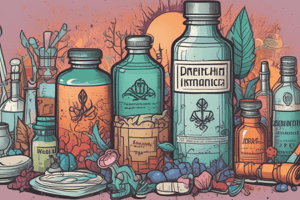Podcast
Questions and Answers
What is the purpose of DATA 2000?
What is the purpose of DATA 2000?
- To prohibit the use of controlled substances in medical treatment
- To approve controlled substances for the treatment of narcotic addiction (correct)
- To establish guidelines for pharmacists only
- To regulate the sale of controlled substances
Who may dispense an approved controlled substance to a patient?
Who may dispense an approved controlled substance to a patient?
- Only an authorized practitioner
- Only a patient's primary care physician
- Any medical professional registered with the DEA
- A licensed registered pharmacist or an authorized practitioner (correct)
What is the maximum number of patients an authorized practitioner may treat at one time?
What is the maximum number of patients an authorized practitioner may treat at one time?
- No limit, as long as the practitioner is registered with the DEA
- 500 patients
- A limit established by DATA 2000 and the Department of Health and Human Services (HHS) Substance Abuse and Mental Health Services Administration (SAMHSA) (correct)
- 100 patients
What is required on a prescription for an approved controlled substance?
What is required on a prescription for an approved controlled substance?
What is buprenorphine?
What is buprenorphine?
Who must approve an authorized practitioner for the treatment of narcotic addiction?
Who must approve an authorized practitioner for the treatment of narcotic addiction?
What is the purpose of Article 32 of the Mental Hygiene Law?
What is the purpose of Article 32 of the Mental Hygiene Law?
What agency has established guidelines for the total number of patients an authorized practitioner may treat at one time?
What agency has established guidelines for the total number of patients an authorized practitioner may treat at one time?
Flashcards are hidden until you start studying
Study Notes
Authorized Practitioners and Pharmacies for Narcotic Addiction Treatment
- Under DATA 2000, authorized practitioners can prescribe, administer, or dispense approved controlled substances for treating narcotic addiction.
- Licensed pharmacists can dispense approved controlled substances for treating narcotic addiction.
Approved Controlled Substances
- Buprenorphine is an approved controlled substance for treating narcotic addiction, as approved by the FDA and the NY State Department of Health.
Authorized Practitioners
- An authorized practitioner must be registered with the DEA to prescribe, administer, or dispense approved controlled substances for treating narcotic addiction.
- The practitioner must be approved under Article 32 of the Mental Hygiene Law.
- The total number of patients an authorized practitioner can have at one time is limited by DATA 2000 and HHS SAMHSA.
Prescribing and Dispensing
- Authorized practitioners must include their unique DEA identification number on prescriptions for approved controlled substances.
- Practitioners may dispense approved controlled substances in accordance with Public Health Law Section 3331 and this Part Section 80.71.
- Pharmacists can dispense approved controlled substances pursuant to a prescription issued by an authorized practitioner, in accordance with Public Health Law Section 3333 and this Part Section 80.74.
Studying That Suits You
Use AI to generate personalized quizzes and flashcards to suit your learning preferences.




